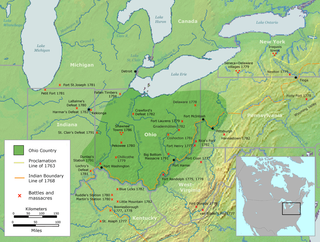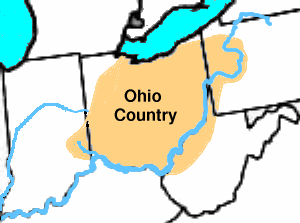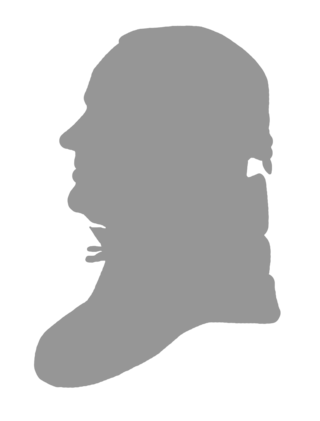
The Allegheny River is a 325-mile-long (523 km) tributary of the Ohio River that is located in western Pennsylvania and New York in the United States. It runs from its headwaters just below the middle of Pennsylvania's northern border, northwesterly into New York, then in a zigzag southwesterly across the border and through Western Pennsylvania to join the Monongahela River at the Forks of the Ohio at Point State Park in Downtown Pittsburgh, Pennsylvania.

The Royal Proclamation of 1763 was issued by King George III on 7 October 1763. It followed the Treaty of Paris (1763), which formally ended the Seven Years' War and transferred French territory in North America to Great Britain. The Proclamation at least temporarily forbade all new settlements west of a line drawn along the Appalachian Mountains, which was delineated as an Indian Reserve. Exclusion from the vast region of Trans-Appalachia created discontent between Britain and colonial land speculators and potential settlers. The proclamation and access to western lands was one of the first significant areas of dispute between Britain and the colonies and would become a contributing factor leading to the American Revolution. The 1763 proclamation line is more or less similar to the Eastern Continental Divide, extending from Georgia in the south to the divide's northern terminus near the middle of the north border of Pennsylvania, where it intersects the northeasterly St. Lawrence Divide, and extends further through New England.

The Transylvania Colony, also referred to as the Transylvania Purchase or the Henderson Purchase, was a short-lived, extra-legal colony founded in early 1775 by North Carolina land speculator Richard Henderson, who formed and controlled the Transylvania Company. Henderson and his investors had reached an agreement to purchase a vast tract of Cherokee lands west of the southern and central Appalachian Mountains through the acceptance of the Treaty of Sycamore Shoals with most leading Cherokee chieftains then controlling these lands. In exchange for the land the tribes received goods worth, according to the estimates of some scholars, about 10,000 British pounds. To further complicate matters, this frontier land was also claimed by the Virginia Colony and a southern portion by Province of North Carolina.
Trans-Appalachia is an area in the United States bounded to the east by the Appalachian Mountains and extending west roughly to the Mississippi River. It spans from the Midwest to the Upper South. The term is used most frequently when referring to the area as a frontier in the 18th and 19th century. During this period, the region gained its own identity, defined by its isolation and separation from the rest of the United States to the east. It included much of Ohio Country and at least the northern and eastern parts of the Old Southwest. It was never an organized territory or other political unit. Most of what was referred to by this name became the states of western Pennsylvania, Ohio, West Virginia, Kentucky, Tennessee and western Virginia. It is still a vague and little used place name today.

The Ohio Country was a name used for a loosely defined region of colonial North America west of the Appalachian Mountains and south of Lake Erie.

Lord Dunmore's War, also known as Dunmore's War, was a brief conflict in fall 1774 between the British Colony of Virginia and the Shawnee and Mingo in the trans-Appalachian region of the colony south of the Ohio River. Broadly, the war included events between May and October 1774. The governor of Virginia during the conflict was John Murray, 4th Earl of Dunmore, who in May 1774, asked the House of Burgesses to declare a state of war with the Indians and call out the Virginia militia.

The history of Pennsylvania stems back thousands of years when the first indigenous peoples occupied the area of what is now Pennsylvania. In 1681, Pennsylvania became an English colony when William Penn received a royal deed from King Charles II of England. However, European activity in the region precedes that date. The area was home to the Lenape, Susquehannocks, Iroquois, Erie, Shawnee, Arandiqiouia, and other American Indian tribes. Most of these tribes were driven off or reduced to remnants as a result of diseases, such as smallpox.

The Ohio Company, formally known as the Ohio Company of Virginia, was a land speculation company organized for the settlement by Virginians of the Ohio Country and to trade with the Native Americans. The company had a land grant from Britain and a treaty with Indians, but France also claimed the area, and the conflict helped provoke the outbreak of the French and Indian War.

The Treaty of Fort Stanwix was a treaty signed between representatives from the Iroquois and Great Britain in 1768 at Fort Stanwix. It was negotiated between Sir William Johnson, his deputy George Croghan, and representatives of the Iroquois.

William Crawford was an American military officer and surveyor who worked as a land agent alongside George Washington while Washington was a teenager. Crawford fought in the French and Indian War, Lord Dunmore's War and the American Revolutionary War arising to the rank of Colonel. In 1782, his unit was attacked, and while he and his surgeon escaped for less than one day, Crawford was eventually captured where he was tortured and burned at the stake by Crawford's former soldier turned British agent, Simon Girty, and Captain Pipe, a Chief of the Delaware Nation.
George Croghan was an Irish-born fur trader in the Ohio Country of North America who became a key early figure in the region. In 1746 he was appointed to the Onondaga Council, the governing body of the Iroquois, and remained so until he was banished from the frontier in 1777 during the American Revolutionary War. Emigrating from Ireland to Pennsylvania in 1741, he had become an important trader by going to the villages of Indigenous Peoples, learning their languages and customs, and working on the frontier where previously mostly French had been trading. During and after King George's War of the 1740s, he helped negotiate new treaties and alliances for the British with Native Americans.

The western theater of the American Revolutionary War (1775–1783) was the area of conflict west of the Appalachian Mountains, the region which became the Northwest Territory of the United States as well as what would become the states of Arkansas, Kentucky, Louisiana, Missouri, and Tennessee. The western war was fought between American Indians with their British allies in Detroit, and American settlers south and east of the Ohio River, and also the Spanish as allies of the latter.

William Irvine was an Irish-American physician, soldier, and statesman from Carlisle, Pennsylvania. He practiced medicine as a ship's surgeon for the Royal Navy before he sympathized with the American Revolution and fought against the British during the American Revolutionary War. As tensions escalated between the American colonies and the British government during the 1770s, Irvine sympathized and allied himself with the revolutionary cause. He subsequently served as a brigadier general in the American Revolutionary War and served in the western theater. After the war he served in the Continental Congress, and later played an active role in ending the Whiskey Rebellion in Pennsylvania. He also served one term in Congress representing Pennsylvania, and was also active in the state's other public affairs.

Yohogania County was created by the new state of Virginia in 1776, in an area long disputed between Virginia and Pennsylvania. The county ceased to exist after the border dispute between the two states was resolved in the 1780s. Thus, it is sometimes referred to as a "lost county," although 1.5 million people live within the territory it once claimed, which encompasses two entire counties and parts of four others in two states.

Hugh Henry Brackenridge was an American writer, lawyer, judge, and justice of the Supreme Court of Pennsylvania.

Charlotina was the suggested name for a popularly proposed British crown colony which was to be established in America following the end of the Seven Years' War, in which Great Britain had acquired a large portion of New France in 1763. However, the proposal was met with little official enthusiasm, as the British government's Royal Proclamation of 1763 forbade the creation of new colonies in the Mississippi and Ohio Valleys. Had such a colony been founded, it would have included the region lying west of the Maumee and Wabash rivers; north of the Ohio River; east of the upper Mississippi River; and south of the Great Lakes. These boundaries would include portions of modern-day Minnesota, Ohio, Indiana, and the entirety of Michigan, Illinois, and Wisconsin. Charlotina would have included modern-day cities such as Chicago, Milwaukee, Toledo, Detroit, Fort Wayne, and parts of Minneapolis and St. Paul.

John Neville was an American military officer, land speculator, and local official who served in the French and Indian War, Lord Dunmore's War and the American Revolutionary War. As an early federal tax collector he became a central figure in the Whiskey Rebellion.

"Indian Reserve" is a historical term for the largely uncolonized land in North America that was claimed by France, ceded to Great Britain through the Treaty of Paris (1763) at the end of the Seven Years' War—also known as the French and Indian War—and set aside for the First Nations in the Royal Proclamation of 1763. The British government had contemplated establishing an Indian barrier state in a portion of the reserve west of the Appalachian Mountains, bounded by the Ohio and Mississippi rivers and the Great Lakes. British officials aspired to establish such a state even after the region was assigned to the United States in the Treaty of Paris (1783) ending the American Revolutionary War, but abandoned their efforts in 1814 after losing military control of the region during the War of 1812.

Vandalia was the name in the late 1700s of a proposed British colony in North America. The colony would have been located south of the Ohio River, primarily in what are now West Virginia and northeastern Kentucky.

Thomas Gaddis (1742–1834) was a militia officer in the American Revolutionary War. He was born December 28, 1742, in Winchester, Frederick County, Virginia and married Hannah Rice in 1764; the same year he built Fort Gaddis, a refuge from the Indians, located on the Catawba Trail. In fact, Pennsylvania and Virginia had conflicting claims in the area Gaddis settled. Though he maintained his loyalty to Virginia, Gaddis also protected his investment by recording his patent with Pennsylvania authorities. By 1773, both states created new geo-political boundaries in recognition of increased white settlement. Pennsylvania formed Westmoreland County out of the larger Bedford County, and Virginia established the District of West Augusta. In 1776, West Augusta was further divided into three counties: Ohio, Yohogania, and Monongalia, where Gaddis and his family resided.


















